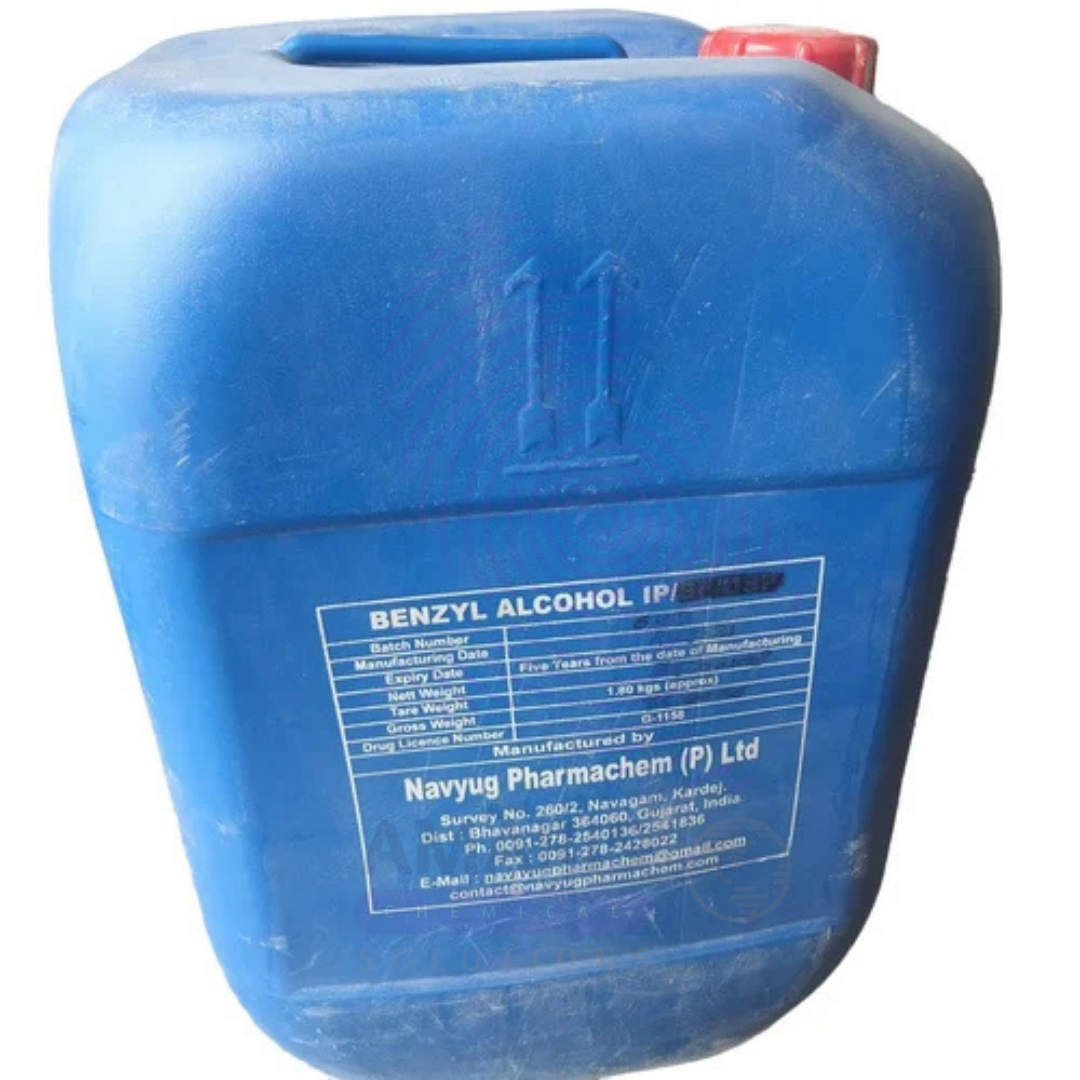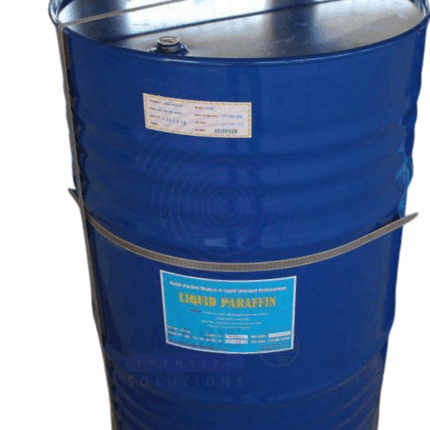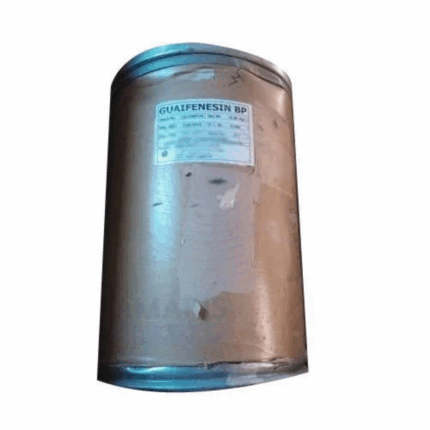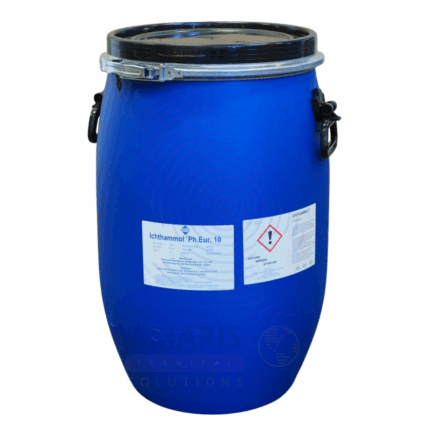Benzyl Alcohol
Whatsapp Order
Benzyl Alcohol is an aromatic alcohol with a mild pleasant odor and clear, colorless liquid appearance. It serves as a versatile solvent, preservative, and intermediate in chemical synthesis. Benzyl Alcohol is widely used across pharmaceuticals, cosmetics, paints, coatings, and as a bacteriostatic agent in injectable drugs. Its relatively low toxicity and good solvent properties make it valuable in both industrial and consumer products.
Description
Table of Contents
Toggle
Benzyl Alcohol
Primary Uses
Pharmaceuticals & Medical
- Used as a bacteriostatic preservative in injectable drugs and intravenous solutions.
- Acts as a solvent for various active pharmaceutical ingredients (APIs).
- Included in topical, ophthalmic, and nasal formulations for its antimicrobial properties.
Cosmetics & Personal Care
- Serves as a preservative and solvent in creams, lotions, shampoos, and other personal care products.
- Used in fragrances and perfumes as a solvent and fixative.
- Included for its antimicrobial properties in skin care formulations.
Industrial Applications
- Solvent in paints, coatings, inks, and varnishes due to its moderate evaporation rate.
- Used in manufacturing plasticizers, dyes, and synthetic flavors/fragrances.
- Intermediate in the synthesis of various chemicals including esters and benzyl derivatives.
Food Industry
- Used as a flavoring agent and preservative in some food products (regulated usage).
Secondary Uses
- Employed in printing and textile industries as a solvent for dyes and inks.
- Utilized in the synthesis of esters for plasticizers and perfumes.
- Used in woodworking and cleaning applications as a solvent and preservative.
PRODUCT KEY FEATURES
- Basic Identification Attributes
- Chemical Name (IUPAC): Benzyl alcohol
- Common/Trade Names: Benzyl Alcohol, Phenylcarbinol
- CAS Number: 100-51-6
- HS Code: 2914.39.00
- Molecular Formula: C7H8O
- Synonyms: Phenylmethanol, Benzenemethanol
- Physical & Chemical Properties
- Physical State: Colorless liquid
- Color & Odor: Colorless, mild pleasant aromatic odor
- Melting Point: -15°C
- Boiling Point: 205.3°C
- Density: 1.04 g/cm³
- Solubility: Slightly soluble in water (~4 g/100 mL at 20°C), miscible with most organic solvents
- pH Level: Neutral to slightly acidic
- Vapor Pressure: 0.13 mm Hg at 25°C
- Flash Point: 93°C (closed cup)
- Autoignition Temperature: 450°C
- Viscosity: ~4.3 mPa·s at 20°C
- Safety & Hazard Attributes
- Hazard Class (GHS): Flammable liquid, Category 4
- NFPA Ratings: Health 1, Flammability 2, Reactivity 0
- Exposure Limits: OSHA PEL = 10 ppm (benzyl alcohol vapor)
- Reactivity: Stable under normal conditions; incompatible with strong oxidizers
- Toxicity: Low acute toxicity; may cause skin or eye irritation on prolonged exposure
- Storage & Handling Attributes
- Storage Conditions: Store in a cool, well-ventilated area away from heat or ignition sources
- Container Type: Glass or metal containers recommended
- Shelf Life: Typically 2–3 years under proper storage
- Special Handling: Use gloves and eye protection; prevent vapor buildup and avoid inhalation
- Regulatory & Compliance Attributes
- FDA: Approved for use as a food additive and in pharmaceuticals
- EU: Approved for use in cosmetics (INCI name Benzyl Alcohol) and food flavoring
- Transportation: Classified as flammable liquid; handle according to regulations
- Waste Disposal: Dispose of according to local environmental regulations
- Environmental & Health Impact
- Ecotoxicity: Low to moderate toxicity to aquatic life; avoid environmental release
- Persistence: Biodegradable under aerobic conditions
- Carcinogenicity: Not classified as carcinogenic by IARC or OSHA
Biodegradability: Readily biodegradable
SAFETY HANDLING PRECAUTIONS
Safety Handling Precautions
- PPE: Use chemical-resistant gloves, safety goggles, and protective clothing.
- Ventilation: Handle in well-ventilated areas to avoid vapor accumulation.
- Fire Safety: Keep away from open flames, sparks, and hot surfaces. Use proper grounding to prevent static discharge.
- Spill Response: Absorb spills with inert material; avoid release into drains or environment.
- Hygiene: Wash hands thoroughly after handling; avoid ingestion and inhalation.
First Aid Measures
- Inhalation: Move to fresh air; seek medical attention if respiratory irritation or difficulty occurs.
- Skin Contact: Wash thoroughly with soap and water; remove contaminated clothing; seek medical care if irritation persists.
- Eye Contact: Rinse immediately with plenty of water for at least 15 minutes; seek medical attention if irritation continues.
- Ingestion: Rinse mouth; do not induce vomiting; seek immediate medical assistance.
Firefighting Measures
- Fire Hazards: Flammable liquid; vapors may ignite and cause flash fires.
- Extinguishing Media: Use foam, dry chemical, carbon dioxide, or water spray.
- Special Precautions: Firefighters should wear full protective gear and self-contained breathing apparatus (SCBA). Cool containers exposed to fire with water spray.
Related products
Carbocisteine AJI 92
Carbocisteine AJI 92 is a high-purity pharmaceutical-grade amino acid derivative, chemically known as S-carboxymethyl-L-cysteine. It is a white to off-white crystalline powder with a slightly sulfurous odor and is freely soluble in water. Carbocisteine functions primarily as a mucolytic agent—reducing the viscosity of mucus and promoting expectoration in respiratory tract infections. The "AJI 92" specification refers to its compliance with the purity standards established by Ajinomoto's amino acid quality benchmarks, ensuring it meets stringent pharmaceutical-grade quality control for active pharmaceutical ingredients (APIs). It is widely used in oral syrups, tablets, and granules in both human and veterinary medicine.
Cetirizine Hydrochloride (Cetirizine HCl)
Cetirizine Hydrochloride is a widely used second-generation antihistamine effective for treating allergic conditions such as allergic rhinitis, chronic urticaria, and other allergy symptoms. It is the hydrochloride salt form of cetirizine, existing as a white to off-white crystalline powder with a slightly bitter taste. Cetirizine HCl acts by selectively blocking peripheral H1 histamine receptors, thereby reducing allergic symptoms without significant sedation or central nervous system depression. It is commonly formulated into tablets, syrups, and capsules as an active pharmaceutical ingredient.
Diphenhydramine HCL BP
Diphenhydramine HCL BP is a first-generation antihistamine with potent anticholinergic, sedative, and antiemetic properties. It is commonly used to relieve symptoms associated with allergies, hay fever, the common cold, and motion sickness. Diphenhydramine HCL is a white crystalline powder, highly soluble in water, making it suitable for oral, topical, and injectable pharmaceutical formulations. Due to its ability to cross the blood-brain barrier, it causes sedation and is often used as a sleep aid and for managing Parkinson’s disease symptoms.
Guaiphenesin BP
Guaiphenesin BP is a white crystalline powder or granules with a faint characteristic odor, classified as an expectorant used primarily in pharmaceutical formulations to relieve chest congestion. It works by loosening and thinning mucus in the airways, making it easier to cough up and clear from the respiratory tract. It is widely utilized in cough syrups, tablets, and cold remedies. Recognized for its mucolytic and muscle-relaxant properties, Guaiphenesin is included in both prescription and over-the-counter medications worldwide.
Hydrocortisone Base BP Micro
Hydrocortisone Base BP Micro is a highly purified, micronized form of hydrocortisone base compliant with British Pharmacopoeia (BP) standards. It is a white to off-white fine powder designed for enhanced solubility and bioavailability in pharmaceutical formulations. As a corticosteroid hormone analog, it exhibits potent anti-inflammatory, immunosuppressive, and anti-allergic activities. The micronized particle size (~93 microns) facilitates improved dispersion in topical, injectable, and oral dosage forms.
Ichthammol BP98
Ichthammol BP98, also known as ammonium bituminosulfonate, is a dark brown to black, viscous, sulfur-rich, semi-solid substance derived from the distillation of shale or bituminous rocks. It has a characteristic tar-like odor and is highly valued in pharmaceutical and dermatological applications for its anti-inflammatory, antiseptic, antipruritic (anti-itch), and keratolytic properties. Ichthammol penetrates deeply into the skin and soft tissues, helping to alleviate inflammation and promote healing. It is widely used in topical preparations for treating skin conditions such as eczema, psoriasis, boils, abscesses, and other dermatological infections.
Mepyramine Maleate BP
Mepyramine Maleate BP is an antihistamine drug commonly used to relieve allergic symptoms such as hay fever, urticaria, and other allergic reactions. It works by blocking histamine H1 receptors, reducing allergic responses like itching, swelling, and redness. This compound is a white or off-white crystalline powder, soluble in water and alcohol, widely used in pharmaceutical formulations including tablets, creams, and injectables.
Methyl Salicylate BP
Methyl Salicylate BP is a clear, colorless to pale yellow oily liquid with a characteristic strong, sweet, and minty odor. It is an organic ester commonly used for its analgesic, anti-inflammatory, and flavoring properties. Methyl Salicylate is widely used in pharmaceutical preparations, topical pain relief products, cosmetics, and as a fragrance ingredient.


 Preservatives(food)
Preservatives(food) Flavor Enhancers
Flavor Enhancers Acidulants
Acidulants Sweeteners
Sweeteners Antioxidants
Antioxidants Colorants(food)
Colorants(food) Nutraceutical Ingredients (food)
Nutraceutical Ingredients (food) Nutrient Supplements
Nutrient Supplements Emulsifiers
Emulsifiers
 Collectors
Collectors Dust Suppressants
Dust Suppressants Explosives and Blasting Agents
Explosives and Blasting Agents Flocculants and Coagulants
Flocculants and Coagulants Frothers
Frothers Leaching Agents
Leaching Agents pH Modifiers
pH Modifiers Precious Metal Extraction Agents
Precious Metal Extraction Agents
 Antioxidants(plastic)
Antioxidants(plastic) Colorants (Pigments, Dyes)
Colorants (Pigments, Dyes) Fillers and Reinforcements
Fillers and Reinforcements Flame Retardants
Flame Retardants Monomers
Monomers Plasticizers
Plasticizers Polymerization Initiators
Polymerization Initiators Stabilizers (UV, Heat)
Stabilizers (UV, Heat)
 Antifoaming Agents
Antifoaming Agents Chelating Agents
Chelating Agents Coagulants and Flocculants
Coagulants and Flocculants Corrosion Inhibitors
Corrosion Inhibitors Disinfectants and Biocides
Disinfectants and Biocides Oxidizing Agents
Oxidizing Agents pH Adjusters
pH Adjusters Scale Inhibitors( water)
Scale Inhibitors( water)
 Antioxidants(cosmetic)
Antioxidants(cosmetic) Emollients
Emollients Fragrances and Essential Oils
Fragrances and Essential Oils Humectants
Humectants Preservatives
Preservatives Surfactants(cosmetic)
Surfactants(cosmetic) Thickeners
Thickeners UV Filters
UV Filters
 Fertilizers
Fertilizers Soil Conditioners
Soil Conditioners Plant Growth Regulators
Plant Growth Regulators Animal Feed Additives
Animal Feed Additives Biostimulants
Biostimulants Pesticides (Herbicides, Insecticides, Fungicides)
Pesticides (Herbicides, Insecticides, Fungicides)
 Active Pharmaceutical Ingredients (APIs)
Active Pharmaceutical Ingredients (APIs) Excipients
Excipients Solvents(pharmaceutical)
Solvents(pharmaceutical) Antibiotics
Antibiotics Antiseptics and Disinfectants
Antiseptics and Disinfectants Vaccine Adjuvants
Vaccine Adjuvants Nutraceutical Ingredients (pharmaceutical)
Nutraceutical Ingredients (pharmaceutical) Analgesics & Antipyretics
Analgesics & Antipyretics
 Analytical Reagents
Analytical Reagents Solvents(lab)
Solvents(lab) Chromatography Chemicals
Chromatography Chemicals Spectroscopy Reagents
Spectroscopy Reagents microbiology-and-cell-culture-reagents
microbiology-and-cell-culture-reagents Molecular Biology Reagents
Molecular Biology Reagents Biochemical Reagents
Biochemical Reagents Inorganic and Organic Standards
Inorganic and Organic Standards Laboratory Safety Chemicals
Laboratory Safety Chemicals Specialty Laboratory Chemicals(Special Laboratory Equipment)
Specialty Laboratory Chemicals(Special Laboratory Equipment)
 Demulsifiers
Demulsifiers Hydraulic Fracturing Fluids
Hydraulic Fracturing Fluids Scale Inhibitors(oil)
Scale Inhibitors(oil) Surfactants(oil)
Surfactants(oil) Drilling Fluids
Drilling Fluids
 Dyes and Pigments
Dyes and Pigments Bleaching Agents
Bleaching Agents Softening Agents
Softening Agents Finishing Agents
Finishing Agents Antistatic Agents
Antistatic Agents
 Admixtures
Admixtures Waterproofing Agents
Waterproofing Agents Sealants and Adhesives
Sealants and Adhesives Curing Compounds
Curing Compounds Concrete Repair Chemicals
Concrete Repair Chemicals Anti-Corrosion Coatings
Anti-Corrosion Coatings
 Surfactants(cleaning)
Surfactants(cleaning) Builders
Builders Enzymes
Enzymes Solvents (Cleaning)
Solvents (Cleaning) Fragrances
Fragrances
 Electronic Chemicals
Electronic Chemicals Catalysts
Catalysts Lubricants
Lubricants Photographic Chemicals
Photographic Chemicals Refrigerants
Refrigerants Automotive chemicals
Automotive chemicals Pyrotechnic Chemicals
Pyrotechnic Chemicals
 Biodegradable Surfactants
Biodegradable Surfactants Bio-based Solvents
Bio-based Solvents Renewable Polymers
Renewable Polymers Carbon Capture Chemicals
Carbon Capture Chemicals Wastewater Treatment Chemicals
Wastewater Treatment Chemicals
 Pigments
Pigments Solvents(paint)
Solvents(paint) Specialty Coatings
Specialty Coatings Binders/Resins
Binders/Resins Additives
Additives Driers
Driers Anti-Corrosion Agents
Anti-Corrosion Agents Functional Coatings
Functional Coatings Application-Specific Coatings
Application-Specific Coatings
 Fresh Herbs
Fresh Herbs Ground Spices
Ground Spices Whole Spices
Whole Spices Spice Blends
Spice Blends Dried Herbs
Dried Herbs
 Leavening Agents
Leavening Agents Dough Conditioners
Dough Conditioners Flour Treatments
Flour Treatments Fat Replacers
Fat Replacers Decoratives
Decoratives Preservatives(baking)
Preservatives(baking)
 Plasticizers & Softeners
Plasticizers & Softeners Reinforcing Agents
Reinforcing Agents Adhesion Promoters
Adhesion Promoters Vulcanizing Agents
Vulcanizing Agents Antidegradants
Antidegradants Blowing Agents
Blowing Agents Fillers & Extenders
Fillers & Extenders Accelerators & Retarders
Accelerators & Retarders

























